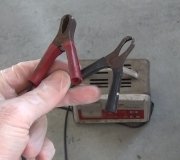It sounds as though you have a battery drain.
Test for a drain on the battery by a using an ammeter. Disconnect the negative battery terminal and hook the ammeter with the positive test lead on the disconnected negative battery cable and negative test lead on negative battery post. Turn everything off, close the doors and if you have a hood light remove the bulb.
With the negative battery terminal disconnected, an ammeter between the cable and post see if you have a drain showing on ammeter. A reading on the ammeter over fifty milliamps shows that something is draining the battery. If so, start by unhooking the small wires at the alternator and see if the ammeter drops to under fifty milliamps. If the ammeter now reads zero or less than fifty milliamps then you have found the short. If the ammeter is still more than fifty milliamps, the short is somewhere else. If the ammeter just drops some, you still have a drain somewhere else so start pulling the fuses one at a time and when you do find out when you pull a fuse and the drain gets lower then put the fuse back in hook up the battery and make sure everything on that circuit works. Let me know which fuse you pulled and I will upload the wiring diagram so you can check everything on that circuit and make sure that it works. If something does not work on the circuit that is causing the drain then it may be short-circuited with another circuit of shorted to ground. That may help find where the short is if something don't work. So with your twelve volt test light or voltmeter test the wiring to whatever does not work to find out where it has voltage and all of a sudden looses voltage and then repair that spot. If any drop some or allot write it down which fuse it was and write down how much milliamps it dropped. Remember if you have to keep the door open to pull the fuses just push in on the door switch after every time you pull a fuse and go to look at the meter. When all fuses are pulled and the alternator wires are off you should have no drain and written down everything that was causing a drain. If you still have a drain with every fuse pulled and the alternator wires off, then it must be something that is un-fused such as anything that may be fed from the light switch or fed from a fusible link.
Last if you have all the fuses out and still have a drain disconnect the big wire at the alternator. If the drain now goes away you have a bad diode in alternator.
Wednesday, November 29th, 2017 AT 2:46 PM



